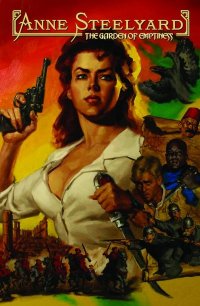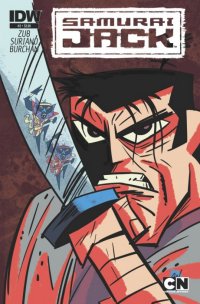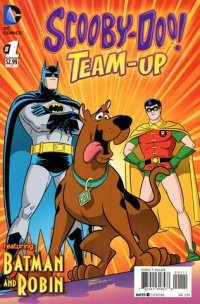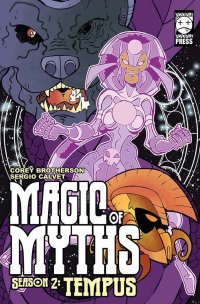Anne Steelyard: Garden of Emptiness Vol.1 ($2.99, Penny Farthing Press)
by D.S. Randlett (@dsrandlett)
It’s not every day that a digital release from a publisher that you’ve never heard of blows you away a little bit.
The best possible description of Anne Steelyard also happens to be completely inadequate. Going by the cover, you can probably guess what that is: feminist Indiana Jones. And you’d be right about that. But that description doesn’t begin to capture what’s so wonderful about this book. It doesn’t convey, for example, the deftness with which it captures the atmosphere of Constantinople before World War I breaks out, and the smouldering tensions that hang in the city’s air. Nor does it convey the sense of a changing of the historical guard that gives the book an element of power. Most importantly, it does not capture just how well the characters are written here.
Writer Barbara Hambly stakes out some pretty daunting challenges for any genre writer here. First, there’s the genre itself. Us comics geeks often have an affection for the trappings of the old pulp stories. Adventures in ancient buried cities! Hidden relics! Robotic gorilla demons! What’s not to love, right? But too often, when one looks at the original sources for those ideas, he or she can come away quite disturbed by the racist, classist, and sexist attitudes that permeate very many of those classic stories, attitudes which often get translated into the modern stories that count them as influences. Second, there’s the oft-used device of inserting female protagonists into stories like this, stories usually written by men who swap out the gender of their principal characters without swapping in the sex. The end results of such endeavors are usually pretty empty in terms of character, making the story an exercise in watching someone do stuff while stuff happens.
Hambly’s script is pretty great in every respect. There’s adventure, romance, and great characters who all bounce off of each other really well, but it’s her handling of the pulp genre and its gender conventions that really make Anne Steelyard come alive. The handling of the character of Anne Steelyard herself is what sets this book apart. She very much lives in a pulp world, with all that entails, that evokes the attitudes of the early nineteen hundred, when Europe’s great powers were simultaneously at their zenith and about to take their last bloody gasps. As a woman, Steelyard, based on real life adventurer Gertrude Bell, is expected to do what her father says, marry who her father wants her to marry, and in all respects be a good little girl. Hambly takes great pains to show how Steelyard’s culture is stacked against her, which makes her and her companions’ gaming of that culture’s systems a lot of fun to watch and gives the sense that Steelyard is a person of great internal daring and not simply someone who likes to “do stuff.” Anne Steelyard is a feminist story in the truest sense, complete with characters who bristle against the cage of patriarchy, but it can be enjoyed on terms apart from that.
The art, penciled by Alex Kosakowski and Ron Randall, with colors by Mike Garcia is simply gorgeous. The artists evoke a feeling resembling the famous Cary Nord and Dave Stewart combo from the early days of Dark Horse’s Conan. The styling of the pencil work is very different from Nord’s. It’s more voluptuous than brawny, for example, and the figures come in a variety of realistic shapes and sizes. The colors owe a lot to Stewart’s work, as here there are no inks, and a similar water color-like digital technique is used, but it’s an instance of a felt influence rather than one of pure aping. There are lots of romantic pinks here (sunsets, dresses that cage our heroine), and the dry yellows of the desert. It’s all great work.
So yeah. Read this.
Rating: 




Out of a Possible 5 Stars
Graig Brings Us Kids Stuff Week!
Samurai Jack #1 & 2 (IDW, $3.99 ea.)
by Graig Kent
There have been Samurai Jack stories told in comics before, but most of them were just 8-pagers buried in DC’s Cartoon Network anthology, so, you know, not the most robust or high-profile reading. DC didn’t do the property much justice. But after theri recent triumph Power Puff Girls #1 I had much higher hopes for IDW’s output.
Leading into the series, I was expecting writer Jim Zub to take more inspiration from the atmospheric elements of Jack, and attempt a largely wordless first issue, but instead he wisely goes bigger, much bigger, and draws from the more adventuresome elements of the show.
After roaming through punishing desert winds (there’s three pages of typical Samurai Jack atmospherics) Jack learns of the Rope of Eons, a magical woven braid that can influence time, but the rope was shredded by Aku and dispersed across the lands. Sensing an opportunity to return home, Jack sets off on a quest to gather the scattered threads together to rebuild the rope and hopefully pull himself backwards in time, to undo the future that is Aku.
In this, Zub has crafted a great multi-issue arc that will still allow him to jump genres and storytelling modes with each issue, feeling like Samurai Jack and yet also allow it to be something different.
As any Jack fan knows, his quests are always destined to be thwarted by Aku in the end, or turn out to be false leads to start with, but it is always in the aesthetics and presentation that Samurai Jack stands out and captivates. Artist Andy Suriano picks up the visual feel of the cartoon, adopting the style for the characters and setting as well as using an agreeable color palette that doesn’t need to stay fixed with that of the cartoon. However, I would like to see Suriano branch out and be more adventuresome in his panel breakdowns. In the first issue they’re umremarkably generic, and the second issue feels a bit more innovative, but it still pales in comparison to the Samurai Jack cartoon, where Genndy Tarkovski and company toyed perpetually with its framing. Comics can be a much more flexible medium than animation when it comes to creativity and storytelling, so Suriano needs to push himself harder and farther, to use the medium’s flexibility in a way the cartoon never could.
It’s still an excellent start, though, destined to appeal to and satisfy any Jack fan.
Rating: 




Out of a Possible 5 Stars
 Scooby-Doo Team-Up #1 (DC Comics, $2.99)
Scooby-Doo Team-Up #1 (DC Comics, $2.99)by Graig Kent
It’s easy for me to convey how big a Scooby-Doo fan I am, it just takes one simple sentence…
Scrappy-Doo is my favourite character.
Yeah, I really don’t like Scooby-Doo all that much. Nor Daphne, Velma, Fred, or Shaggy for that matter. I have a healthy appreciation for the show’s pop-culture status and the sweet (if limited) Hanna-Barbara animation of the 70’s, but the negative-growth of the characters, the formulaic structure of the episodes, and oh, that laugh track… even as a kid laugh tracks drove me nuts, especially on cartoons, because they weren’t ever funny. I think that is Scooby-Doo’s biggest crime, that it’s presented as a comedy, but it’s an even weaker element than the mystery and horror aspects of the show.
Where the show succeeded (and I’m kind of glossing over the fact that there have been a dozen or so iterations of the show), and what I think people remember best about the show, is its guest stars, like the Harlem Globetrotters, The Three Stooges and Batman and Robin. It was quite a trip to bring in a live-action television series or real-world celebrities or even superheroes into Scooby-Doo’s world, and it was enough of a jolt to the usual Scooby formula to elevate the show and the brand above also-rans like Speed Buggy or Jabberjaw. That and a catchy, memorable, easily repeatable theme song.
In this light, Scooby-Doo Team-Up seems like a natural idea for a comic. If people love those New Scooby-Doo movies where the Mystery Inc. gang meet someone famous, why not take advantage of all the Warner Brothers properties and start teaming them up with others? Batman and Robin is a natural starting point, since they’ve done so a couple times before, and it is a comic. Veteran Scooby (and animated Batman) writer Scholly Fisch establishes their familiarity from the moment they set eyes on each other. Both teams are on the case of mysterious, monstrous bat sightings, which Batman suspects is Kirk Langstrom, the Man-Bat. They team up, stop a robbery and save the day.
It’s a done-in-one title (published bi-monthly) so things move at a brisk clip, and there’s no grand arcs at play. Fisch captures the Scooby gang relatively well, but my issues with his script lay in the meta-references, where the Scooby characters say things that make them all too aware of their repetitive behavior and ridiculous lifestyle. It doesn’t really belong, it’s not particularly fresh or funny, and moreover it pulls the reader out of the fantasy.
I’m agog over artist Dario Brizuela though. He captures the Scoobies perfectly but it’s his Batman and Robin which are absolute classic. They look like Super Powers action figures instead of using the Bruce Timm design or even the old Super Friends look. They’re not on-model with any animation version I’ve seen, he just draws them with their most infamous outfits and they look terrific, undies on the outside and all. I love Brizuela’s simple and impeccably clean line work, somewhat reminiscent of Ty Templeton or early Kevin Maguire. Heroic Age comes in with a beautiful and vibrant coloring job, sticking with bright colors and simple shading to add the depth. It looks fantastic.
It’s a great, fun read for the kids, a passable read for adults, but it’s so good looking that I can’t not recommend it. More Batman-related team-ups are in store for the near future (as the series was originally supposed to be a Scooby/Batman team-up mini-series) but expansion into the DCU and beyond is in store.
Rating: 




Out of a Possible 5 Stars
Plants vs. Zombies: Lawnmageddon HC (Dark Horse, $9.99)

by Graig Kent
I love Plants vs. Zombies, so there’s my bias, up front. I’m currently addicted to Plants vs. Zombies 2: It’s About Time to the detriment of my eyeballs, my sanity, and my free time. Pop Cap games has created a series that is silly, but clever, visually distinctive, entertaining, cute and intense all at once. It’s a strategy game, primarily, and as such, it doesn’t have a narrative through line, (though It’s About Time tries to construct a tenuous one about Crazy Dave searching history for the taco he already ate), and given the conceit — pun-tastic plants defend your home against invading hordes of zombies — it doesn’t need one. So when I heard that Dark Horse was producing a comic book mini-series (originally offered through Dark Horse Digital) I was both puzzled how there could be a comic and completely on-board with finding out.
I actually missed the digital run, but was super-psyched to come across the hardcover collection that was just recently released. I had no doubt that it would be a mess of a book trying to mesh the game’s concepts into a workable story, but was curious whether a comic could properly retain the mixture of goofiness and anxiousness that the source does so well.
The result is it is as much as mess as I expected it to be, with writer Paul Tobin (of Bandette fame) creating a couple of tween-aged characters to be our guide through this crazy landscape. Nate Timely is a daydreamer, a kid who loves archetype-mashing (pirate mummies, alien ninjas, cowboy astronauts), and he meet-cutes Patrice Blazing, a brassy, quick-witted young lass in his tree fort. There’s an instant chemistry between them that they don’t really get to explore before noticing the zombie horde outside. They flee the fort to make way to Patrice’s uncle’s house, the guy who all the kids in the neighbourhood known as Crazy Dave.
Dave meanwhile has been preparing for an Alien Ninja onslaught by creating weaponized plants in his greenhouse and seeding them around town (so the plants get an origin, but the zombies just appear out of nowhere, sadly). From there it’s just plants versus zombie melee with these folks getting in between and some sort of objective for them to meet (that really doesn’t matter all that much).
Tobin sows in as many of the game elements as possible, making use of the different types of zombies and plants, and even the bonus Yeti and Zomboss. It’s mainly up to Ron Chan to illustrate it all however and he crams the pages with a ridiculous amount of plants and zombies, which is all terribly fun to look at and scour through.
Where it doesn’t hold true to the game is in its lack of intensity. Tobin and Chan do an excellent job in keeping things upbeat and getting chuckles with Crazy Dave’s gibberish, but there’s no risk here, there’s no sense that anyone’s getting their brains eaten, and the kids are able to move way too freely around the town to make the zombies seem at all threatening. There should be a mix of levity and terror and there really isn’t.
Obviously this is a fans-only book. There’s no crossover appeal here, and that’s okay. Tobin did a solid job with constructing an accessible, all-ages story out of a video game premise, but now that there’s a structure in place, I would like to see boundaries pushed. I see now that a Plants vs. Zombies story can borrow nicely (or rip off entirely) things like Assault On Precinct 13 or The Gauntlet, allowing it to have a bit more weight but still be tremendous fun.
Rating: 




Out of a Possible 5 Stars
 Magic of Myths Season 2: Tempus
Magic of Myths Season 2: Tempus
Doodle Press: $17.83 (including shipping); $25.94 for Season 1 and 2 Omnibus Edition
By Jeb D.
Guess it’s one of those things where there’s just something in the air: following Jonathan Hickman’s God is Dead, which indulges our inner eight-year-old with the question of just what would happen if all those mythical gods and goddesses were, like, giant humanoid kaiju getting into it with each other, the second installment of writer Corey Brotherson and artist Sergio Calvet’s Magic of Myths posits a similar showdown between the split personalities of the gods of the Greek pantheon and their doppelgangers from Rome. For all those that might have wondered who’d win in a fight, Mars or Ares, this book is right up your street.
Of course, there’s more going on here than apocalyptic mirror-image mano a mano. Season 2 continues the saga of Eve, the physically and mentally wounded English teacher who takes on the mantle of heroism in a land of fantasy. Brotherson understands the tropes of the genre, and while Eve and her grouchy mentor, Tink, have the sort of prickly relationship that is standard in this sort of story, Brotherson undercuts the solemnity here and there, making Eve’s fantasy persona a wisecracking hero in the Spider-Man mold (taking out a band of evil dwarves, she quips “Hello, I’m Eve… you must be [PUNCH!] Sleepy? [KICK!] Wheezy? And that must make you [SMASH!] Unconscious!”).
In this volume, we dig deeper into Eve’s difficult personal background, and in the parallells between her earthly life, and her magical one, we see her robbed of resources and weapons in both environments, thrown back on her own “human” resources, so to speak, and facing threats that Brotherson has set up as credibly menacing. He brings layers to the conventional trope of the real world-fantasy inversion, and the storytelling depth of Eve’s “mortal” life has strengthened considerably in Season 2.
Calvet’s art is, if anything, even stronger this time out: his clash of ancient power is less grim and bloody than Di Amorim gives us in God is Dead; it’s closer to a more kid-friendly version of something like 300, but even in his cartoony style, he brings intensity to the combat, and punctuates Eve’s story beats with wit and pathos, as called for. If Brotherson’s script has a fault, it’s that things can get awfully talky as he works to distinguish his story from its similarly fantasy-oriented predecessors, and in future volumes, I hope he’ll find the opportunity to step back a bit more here and there and let his capable partner carry more of the expositional load.
Season 2 of Magic of Myths avoids the frequent pitfalls of modern decompressed storytelling: it advances the story, introduces intriguing new elements, and the ending, while a bit more reliant on cliche than the rest of the book, is a strong setup for Season 3.
Rating: 




Out of a Possible 5 Stars